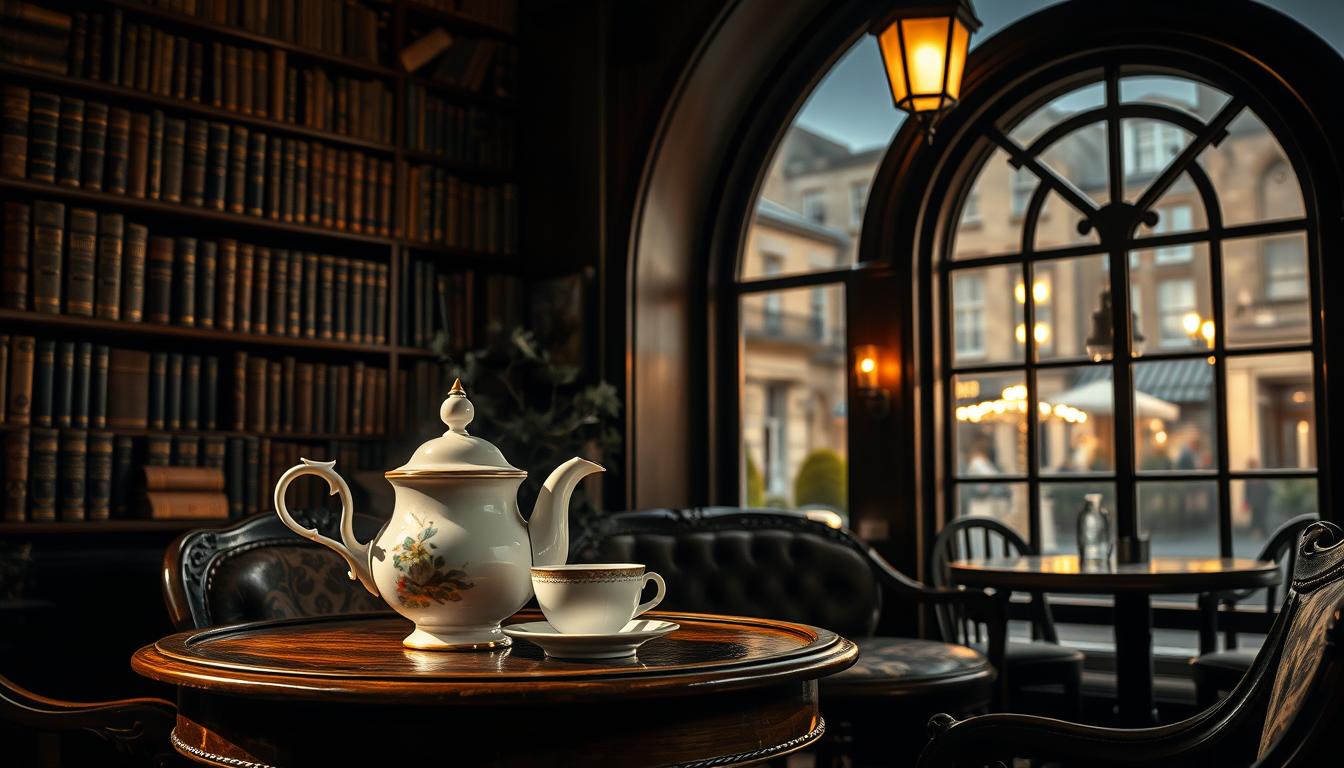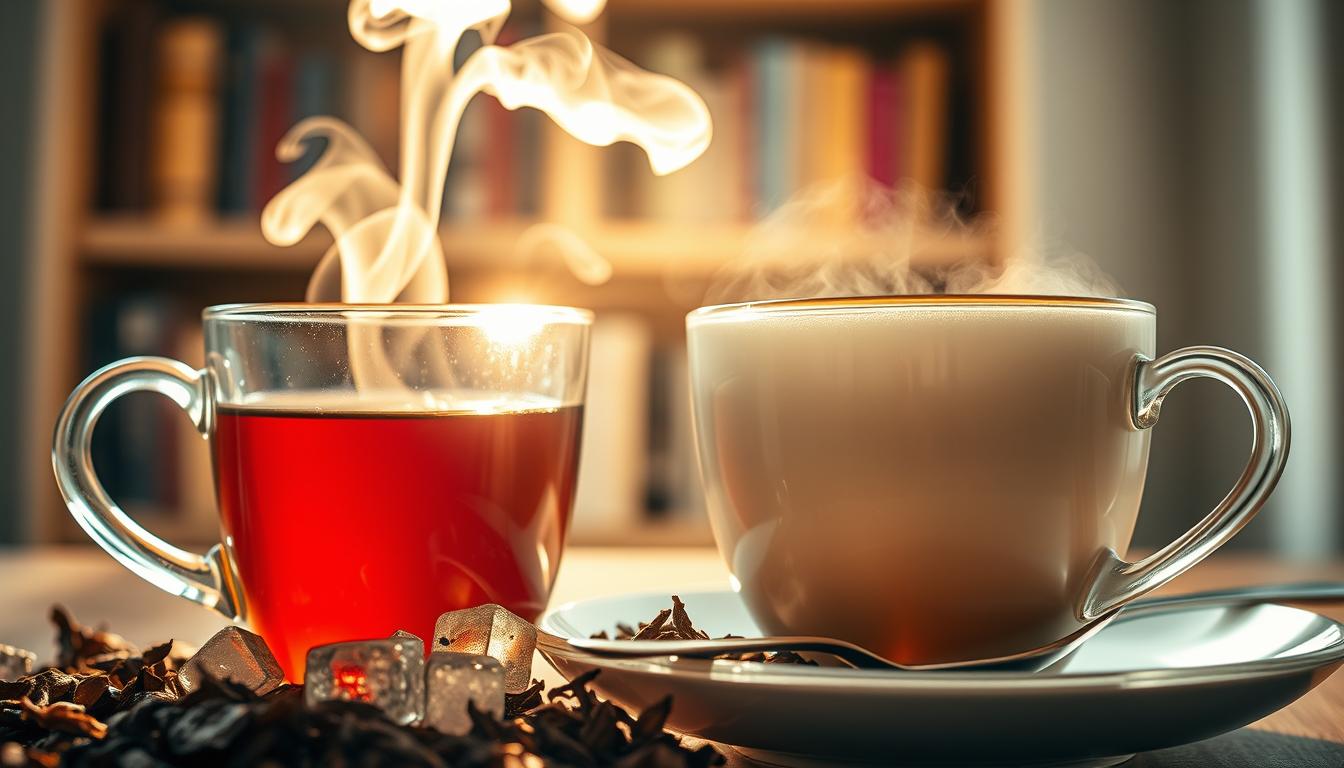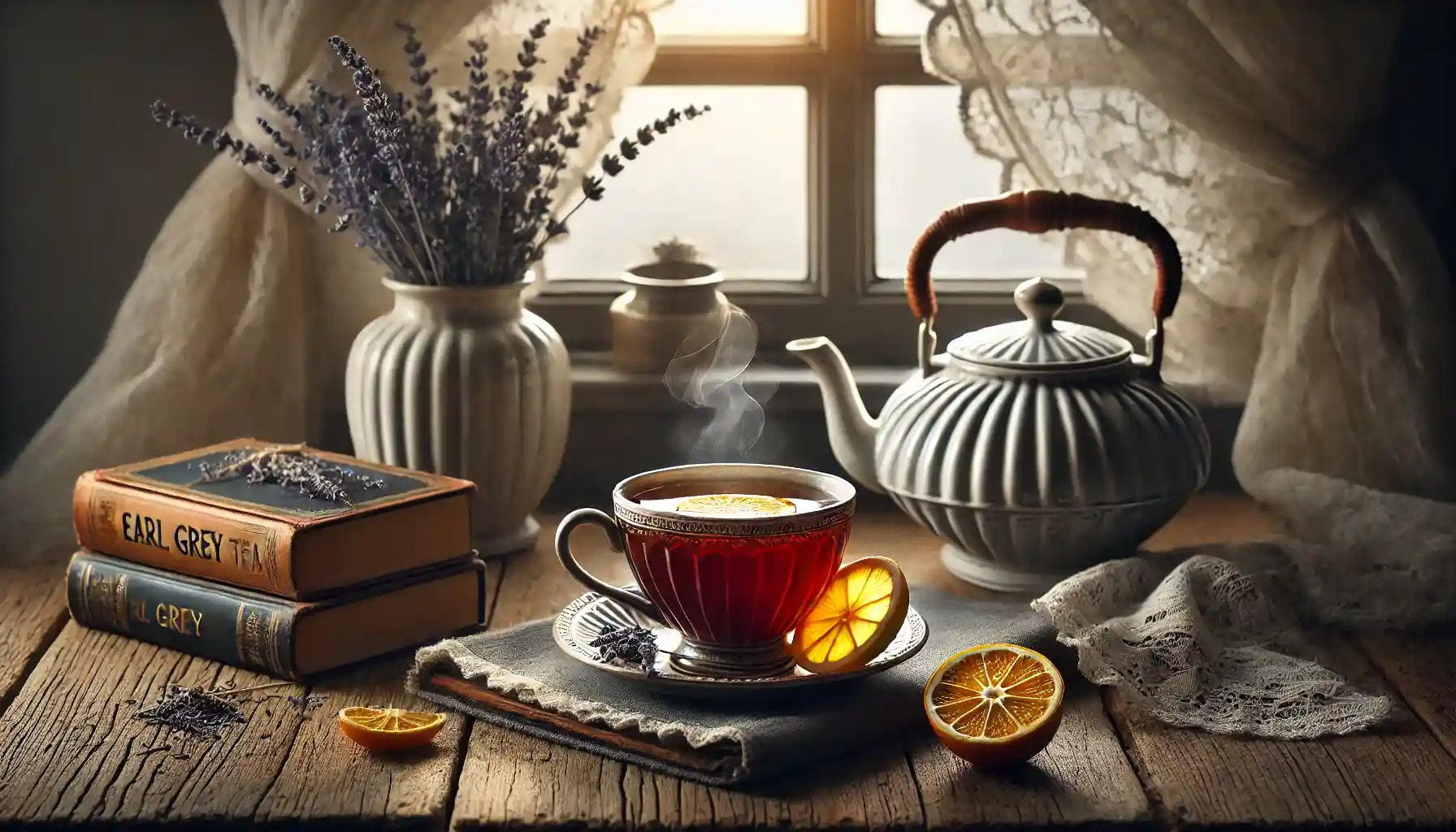Did you know that over 159 million Americans drink tea daily? Among the many varieties, Earl Grey stands out for its unique flavor and aroma. But one question often arises: does it contain caffeine? The answer is yes. This beloved beverage, made from the Camellia sinensis plant, naturally includes caffeine, though in smaller amounts compared to coffee.
Earl Grey’s distinct taste comes from the addition of bergamot oil, which complements the traditional black tea base. While it provides a gentle energy boost, its caffeine content is moderate, making it a popular choice for those seeking a balanced option. In this article, we’ll explore how brewing methods and tea leaves influence caffeine levels, along with tips to enjoy your perfect cup.
Key Takeaways
- Earl Grey tea contains caffeine, sourced from the Camellia sinensis plant.
- Its caffeine levels are lower than those found in coffee.
- Bergamot oil gives Earl Grey its signature citrusy aroma.
- Black tea serves as the base for this classic blend.
- Brewing techniques can affect the caffeine content in your cup.
Introduction to Earl Grey Tea
The story of Earl Grey tea begins with a blend of tradition and innovation. This classic beverage has a rich history that dates back to the 19th century. It’s named after Charles Grey, the 2nd Earl Grey, who served as British Prime Minister. Legend has it that the blend was a gift from a Chinese diplomat, though its exact origins remain debated.

History and Origins
Earl Grey tea evolved from traditional black tea, which was already popular in Britain. The addition of bergamot oil, a citrus fruit extract, gave it a unique twist. This infusion created a signature aroma and flavor that set it apart from other blends. Over time, it became a staple in British tea culture and gained global recognition.
Defining Characteristics and Flavor Profile
What makes Earl Grey tea stand out is its perfect balance of citrusy and floral notes. The bergamot oil adds a refreshing zest, while the black tea base provides a robust foundation. This combination creates a smooth, aromatic cup that appeals to a wide audience.
Compared to coffee, Earl Grey offers a milder caffeine content. Its aroma is distinct, making it a favorite for those who enjoy a fragrant beverage. Below is a comparison of its key features:
| Feature | Earl Grey Tea | Black Tea | Coffee |
|---|---|---|---|
| Caffeine Content | Moderate | Moderate | High |
| Flavor Profile | Citrusy, Floral | Robust, Malty | Bitter, Nutty |
| Aroma | Distinct, Refreshing | Earthy | Strong, Bold |
Earl Grey tea’s background shapes its unique brewing character and cultural significance. Its historical roots and modern appeal make it a timeless choice for tea enthusiasts worldwide.
does earl grey tea have caffeine
Understanding caffeine in beverages starts with its source. The Camellia sinensis plant is the foundation of many popular drinks, including black, green, and oolong varieties. This plant naturally contains caffeine, which is why these beverages provide a gentle energy boost.

Caffeine Basics from the Camellia Sinensis Plant
All teas derived from the Camellia sinensis plant contain caffeine. However, the amount varies depending on the type and processing methods. For example, black tea typically has more caffeine than green tea. This is because oxidation during processing affects caffeine levels.
Factors like brewing time and water temperature also play a role. Longer steeping times and hotter water extract more caffeine. This means you can control the caffeine content in your cup by adjusting these variables.
Overview of Earl Grey’s Caffeine Content
Earl Grey, a black tea blend, contains moderate caffeine levels. On average, a cup has about 40-70 milligrams. This is significantly less caffeine than coffee, which can contain 95 milligrams or more per cup.
Here’s a quick comparison of caffeine content in popular beverages:
- Earl Grey: 40-70 mg per cup
- Black Tea: 40-70 mg per cup
- Green Tea: 20-45 mg per cup
- Coffee: 95 mg or more per cup
By understanding these differences, you can choose the beverage that best suits your needs. Whether you prefer a mild boost or a stronger kick, the type of drink and brewing factors make all the difference.
Factors Affecting Caffeine Content
The caffeine in your cup depends on several key factors. From brewing techniques to the quality of leaves, each element plays a role in determining the final amount. Understanding these variables can help you tailor your drink to your preferences.
Water Temperature and Steeping Time
Hotter water and longer steeping times extract more caffeine from the leaves. For a milder brew, use cooler water and reduce the steeping duration. This method allows you to control the intensity of your drink.
For example, steeping for 3 minutes at 175°F yields a lighter cup, while 5 minutes at 212°F results in a stronger brew. Adjusting these factors can help you achieve the perfect balance.
Processing Methods and Leaf Quality
The way leaves are processed also impacts caffeine levels. Whole leaves retain more caffeine compared to broken or powdered ones. High-quality leaves from the Camellia sinensis plant often provide a richer flavor and higher caffeine content.
Tea bags, which typically contain smaller, broken leaves, may release caffeine faster but in smaller amounts. Whole leaf teas, on the other hand, offer a more gradual extraction, resulting in a smoother experience.
| Factor | Impact on Caffeine |
|---|---|
| Water Temperature | Higher temperature increases extraction |
| Steeping Time | Longer time boosts caffeine levels |
| Leaf Quality | Whole leaves provide higher caffeine |
| Processing Method | Broken leaves release caffeine faster |
By understanding these factors, you can fine-tune your brewing process to match your desired caffeine intake. Whether you prefer a strong kick or a gentle lift, these insights will guide you to the perfect cup.
Comparing Earl Grey with Coffee and Other Teas
When choosing between beverages, caffeine content often plays a key role. Many people wonder how their favorite drinks stack up. Let’s explore how grey tea caffeine compares to coffee and other teas.
Caffeine Comparison with Coffee
An 8-ounce cup earl grey typically contains 40-70 milligrams of caffeine. In contrast, the same amount of coffee packs around 95 milligrams or more. This makes coffee a stronger choice for those seeking a quick energy boost.
However, tea caffeine offers a gentler lift. It’s ideal for those who prefer a milder effect. The temperature and brewing time also influence the final caffeine content in your drink.
Varied Caffeine Levels in Black, Green, and Herbal Teas
Not all teas contain caffeine in the same amounts. Here’s a quick breakdown:
- Black Tea: 40-70 milligrams per cup, similar to Earl Grey.
- Green Tea: 20-45 milligrams per cup, offering a lighter option.
- Herbal Tea: Usually caffeine-free, perfect for a relaxing evening.
Bergamot, the citrus oil used in Earl Grey, enhances the flavor without adding caffeine. This makes it a unique choice for those who enjoy a fragrant, refreshing drink.
By understanding these differences, you can choose the beverage that best suits your needs. Whether you prefer a strong kick or a gentle lift, the temperature and brewing method make all the difference.
Decaffeination and Caffeine Control
For those who love Earl Grey but want less caffeine, decaf options are a great choice. Decaffeinated versions of this classic blend retain the signature flavor while reducing the amount caffeine to trace levels. This makes them ideal for evening enjoyment or for those sensitive to stimulants.
Decaf Options and Their Impact on Flavor
The decaffeination process removes most of the caffeine from the leaves. However, it can also affect the oil content, particularly the bergamot essence that gives Earl Grey its unique aroma. While the flavor remains recognizable, some drinkers notice a slightly milder taste in decaf versions.
Here’s a comparison of caffeine levels in different tea types:
| Tea Type | Caffeine Level |
|---|---|
| Decaf Earl Grey | 2-5 mg per cup |
| Green Tea | 20-45 mg per cup |
| Black Tea | 40-70 mg per cup |
Decaf Earl Grey allows you to enjoy the blend without much caffeine. It’s a great alternative for those who prefer a calming experience. Additionally, brewing methods can further control the caffeine level in your cup earl.
For example, shorter steeping times and cooler water temperatures reduce caffeine extraction. This gives you more control over your drink’s intensity. Whether you choose decaf or adjust your brewing, you can tailor your Earl Grey to suit your needs.
Health Benefits and Flavor Profile
Earl Grey tea offers more than just a delightful taste; it’s packed with health benefits too. From its antioxidant properties to its mood-enhancing effects, this blend is a favorite for both flavor and wellness. Let’s explore how its unique ingredients contribute to your overall health.
Bergamot Oil and Antioxidant Boost
Bergamot oil, the key ingredient in Earl Grey, is rich in polyphenols. These antioxidants help combat free radicals, reducing oxidative stress in the body. This not only supports cellular health but also enhances the tea’s distinct citrusy flavor.
Research shows that regular consumption of antioxidant-rich beverages can improve heart health and boost immunity. With every sip, you’re not just enjoying a flavorful drink but also nurturing your body.
Nutritional Perks and Impact on Mood
Earl Grey contains caffeine, typically around 40-70 milligrams per cup. This moderate level provides a gentle energy boost without the jitters often associated with coffee. Caffeine also aids in improving focus and elevating mood.
Additionally, the blend’s natural compounds may help reduce the risk of depression. Studies suggest that tea drinkers often report lower stress levels and improved mental clarity.
Balancing Energy with Enjoyment
One of the standout features of Earl Grey is its ability to balance energy and relaxation. The milligram caffeine content ensures a mild lift, while the calming aroma of bergamot promotes a sense of well-being.
Whether you’re starting your day or winding down in the evening, this tea offers a harmonious blend of flavor and function. Its unique profile makes it a versatile choice for any occasion.
Tips for the Perfect Brew
Brewing the perfect cup of Earl Grey requires attention to detail and technique. By mastering the process, you can control both the flavor and caffeine levels, ensuring a balanced and enjoyable experience.
Optimal Brewing Time and Tea Leaf Amount
The steeping time plays a crucial role in extracting the right amount of caffeine and bergamot oil. For the best results, steep your tea for three to four minutes. This ensures a rich flavor without bitterness.
Using the proper amount of leaves is equally important. One teaspoon per cup is ideal. Too few leaves result in a weak brew, while too many can make it overly strong.
Water Temperature and Brewing Options
Water temperature affects caffeine extraction, similar to caffeine coffee principles. Avoid boiling water, as it can over-extract tannins and create a bitter taste. Instead, aim for 195-205°F for a smoother cup.
For a tailored experience, consider using high-quality loose leaves instead of tea bags. Loose leaves offer better control over flavor and caffeine levels, making them a superior option.
Alternative Brewing Methods
If you prefer a milder drink, try cold brewing. This method reduces caffeine extraction while preserving the bergamot oil’s aroma. It’s a refreshing option for warmer days.
For those who enjoy variety, blending Earl Grey with herbal tea can create unique flavors. Experiment with chamomile or mint for a soothing twist.
| Factor | Impact |
|---|---|
| Steeping Time | 3-4 minutes for optimal flavor |
| Water Temperature | 195-205°F for smooth extraction |
| Leaf Amount | 1 teaspoon per cup |
| Brewing Option | Loose leaves for better control |
By mastering these techniques, you can enhance both the flavor and health benefits of your brew. Whether you prefer a strong kick or a gentle lift, these tips will guide you to the perfect cup.
Conclusion
Exploring the world of beverages reveals fascinating contrasts in caffeine tea levels. Brewing time, water temperature, and processing methods all play a role in shaping your drink’s intensity. By adjusting these factors, you can tailor your experience to suit your preferences.
Compared to a cup coffee, this blend offers a gentler boost, making it ideal for those who enjoy moderation. The addition of bergamot oil enhances both flavor and health benefits, setting it apart from other options. Its unique aroma and balanced profile make it a versatile choice for any time of day.
Experimenting with brewing techniques allows you to discover your perfect caffeine tea experience. Whether you prefer a stronger brew or a milder option, the right processing and steeping methods can make all the difference. This blend’s gentle lift ensures a relaxed yet alert experience, perfect for mindful enjoyment.
In conclusion, this beverage combines taste and wellness in every sip. Its moderate caffeine tea levels and unique flavor profile make it a standout choice. By mastering the art of brewing, you can enjoy a drink that’s both satisfying and balanced.

